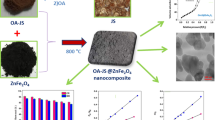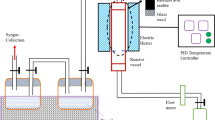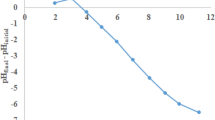Abstract
An efficient and environmentally benign biosorbent for Mo(VI) and W(VI) sequestration was developed by loading Zr(IV) ions onto Saponified Orange Juice Residue (SOJR). An energy-dispersive X-ray (EDX) spectroscopy, Fourier Transform Infra-Red (FTIR) spectroscopy, Thermo-Gravimetric/Differential Thermo-Gravimetric Analysis (TG/DTA), Scanning Electron Microscopy (SEM), X-ray Diffraction (XRD), and chemical analysis techniques were employed to characterize investigated biosorbents. Zr(IV)-loaded SOJR was able to remove oxoanionic species of both the metal ion efficiently at wide pH range, however, pH 5 was preferable for maximum sequestration in batch mode. Langmuir, Freundlich, and Temkin isotherm models were used to examine the equilibrium biosorption, with the Langmuir model having the best correlations with the experimental data. Maximum sequestration capacity of Zr(IV)-SOJR for Mo(VI) and W(VI) were evaluated to be 0.83 and 0.70 mmol/g, respectively. The order of interference caused by investigated co-existing ions were in the order of Cl− < NO3− < CO32− < SO42− < PO43− during Mo(VI) sequestration. Zr(IV)-SOJR having co-ordinated hydroxide ligand were inferred to be substituted by oxoanionic species of Mo(VI) and W(VI) during the sequestration. Elution of adsorbed metal ions could be done using dilute alkali solution and regenerate biosorbent. Therefore, Zr(IV)-SOJR studied in this work is projected to be a low-cost, efficient, and environmentally benign material for effective sequestration of Mo(VI) and W(VI) from water.
Graphical abstract












Similar content being viewed by others
References
Foroutan R, Ahmadlouydarab M, Ramavandi B, Mohammadi R (2018) Studying the physicochemical characteristics and metals adsorptive behavior of CMC-g-HAp/ Fe3O4 nanobiocomposite. J Environ ChemEng 6(5):6049–6058
Liu L, Liu J, Zhao L, Yang Z, Lv C, Xue J, Tang A (2019) Synthesis and characterization of magnetic Fe3O4@ CaSiO3 composites and evaluation of their adsorption characteristics for heavy metal ions. Environ Sci Pollut Res 26(9):8721–8736
Foroutan R, Peighambardoust SJ, Hosseini SS, Akbari A, Ramavandi B (2021) Hydroxyapatite biomaterial production from chicken (femur and beak) and fishbone waste through a chemical less method for Cd2+ removal from shipbuilding wastewater. J Hazard Mater 413:125428
Lipana J, Zhongwei Z, Xuheng L, Lihua H (2020) Recovery of valuable metals from molybdenum-removal sludge by reverse sulfurization leaching. Hydrometallurgy 193:105323
Salazar K., McNutt MK (2012) U.S. Geological survey, metal prices in the United States through 2010. Pubs.Usgs.Gov, 1–204, http://pubs.usgs.gov/sir/2012/5188
Abumrad NN, Schneider SJ, Steel D, Rogress LS (1981) Amino acid intolerance during prolonged total parenteral nutrition reversed by molybdate therapy. Am J ClinNuti 34:2551–2559
Halmi MIE, Ahmad SA (2014) Chemistry, biochemistry, toxicity and pollution of molybdenum: a mini review. J BiochemMicrobiolBiotechnol 2:1–6
National Academy of Sciences (1989) Recommended dietary allowances, 10th edn. DC, National Academy Press, Washington, pp 243–246
El-Moselhy MM, Sengupta AK, Smith R (2010) Carminic acid modified anionexchanger for the adsorption and preconcentration of Mo(VI) from wastewater. J Hazard Mater 185:442–446
Torres J, Gonzatto L, Peinado G, Kremer C, Kremer E (2014) Interaction of molybdenum(VI) oxyanions with +2 metal cations. J Solution Chem 43:1687–1700
Krishnamachari KA, Krishnaswamy K (1974) An epidemiological study of the syndrome of genu valgus among residents of endemic areas for fluorosis in Andhra Pradesh. Indian J Medical Res 62:1415–1423
Barceloux DG (1999) Molybdenum. J ToxicolClinToxicol 37:231–237
Bibak A, Borggaard OK (1994) Molybdenum adsorption by aluminum oxides, iron oxides and humic acid. Soil Sci 158:323–327
Saripalli KP, McGrail BP, Girvin DC (2002) Adsorption of molybdenum on anatase from dilute aqueous solutions. Appl Geochem 17:649–656
Barrow NJ (1970) Comparison of the adsorption of molybdate, sulfate, and phosphate by soils. Soil Sci 109:282–288
Motta MM, Miranda CF (1989) Molybdate adsorption on kaolinite, montmorillonite and illite: constant capacitance modeling. Soil Sci Soc Am J 53:380–385
Sebenik RF, Ference RA (1982) Recovery of metal values from spent cobalt molybdenum/alumina petroleum hydrodesulphurisation and coal liquefaction catalysts: laboratory-scale process and preliminary economics. Preprints Am Chem Soc Div Petr Chem 27(3):674–678
Park KH, Mohapatra D, Reddy BR (2006) Selective recovery of molybdenum from spent HDS catalyst using oxidative soda ash leach/carbon adsorption method. J Hazard Mater 138:311–316
Chen Y, Feng QM, Zhang G, Ou L, Lu Y (2007) Study on the recycling of valuablemetals in spent Al2O3-based catalyst. Miner Metall Process 24(1):30–34
Guo F, Xi X, Ma L, Nie Z, Nie Z (2021) Highly efficient sorption of molybdenum from tungstate solution with modified D301 resin. RSC Adv 11:29939–29947
Zeng L, Cheng CY (2009) A literature review of the recovery of molybdenum and vanadium from spent hydrodesulphurisation catalysts Part II: Separation and purification. Hydrometallurgy 98:10–20
Song Y, Tsuchida Y, Matsumiya M, Uchino Y, Yanagi I (2018) Separation of tungsten and cobalt from WC-Co hard metal wastes using ion-exchange and solvent extraction with ionic liquid. Miner Eng 128:224–229
Roosendael SV, Regadio M, Roosen J, Binnemans K (2019) Selective recovery of indium from iron-rich solutions using an Aliquat 336 iodide supported ionic liquid phase (SILP). Sep Purif Technol 212:843–853
Wu X, Zhang G, Zeng L, Guan W, Wu S, Li Z, Zhou Q, Zhang D, Qing J, Long Y, Li J, Li Q, Cao Z, Xiao L (2020) Continuous solvent extraction operations for the removalof molybdenum from ammonium tungstate solution with quaternary ammonium salt extractant. Hydrometallurgy 195:105401
Ghadiri M, Ashrazadeh SN, Taghizadeh M (2014) Study of molybdenum extraction by trioctylamine and tributylphosphate and stripping by ammonium solutions. Hydrometallurgy 144:151–155
Ahmad AY, Al-Ghouti MA, Khraisheh M, Zouari Z (2022) Insights into the removal of lithium and molybdenum from groundwater by adsorption onto activated carbon, bentonite, roasted date pits, and modified-roasted date pits. Biores Technol 18:101045
Fu Y, Xiao Q, Gao Y, Ning P, Xu H, Zhang Y (2018) Direct extraction of Mo(VI) from acidic leach solution of molybdenite ore by ion exchange resin: Batch and column adsorption studies. Trans Nonferrous Met Soc China 28:1660–1669
MacKeown H, Gyamn A, Delaporte M, Schoutteten KVKM, Verdickt V, Ouddane B, Criquet J (2021) Removal of disinfection by-product precursors by ion exchange resins. J Environ Chem Eng 9:20–24
Paudyal H, Pangani B, Ghimire KN, Inoue K, Ohto K, Kawakita H, Alam S (2012) Adsorption behavior of orange waste gel for some rare-earth ions and its application to the adsorption of fluoride from water. ChemEng J 195–196:289–296
Poudel BR, Aryal RL, Gautam SK, Ghimire KN, Paudyal H, Pokhrel MR (2021) Effective remediation of arsenate from contaminated water by zirconium modified pomegranate peel as an anion exchabger. J Environ ChemEng 9(6):106552
Ghimire KN, Inoue K, Makino K et al (2002) Adsorptive adsorption of arsenic using orange juice residue. Sep Sci Technol 37:2785–2799
Biswas BK, Inoue K, Ghimire KN, Miyajima T (2007) The adsorption of phosphate from an aquatic environment using metal loaded orange waste. J Colloid Interface Sci 312:214–223
Weidner E, Ciesielczyk F (2019) Adsorption of hazardous oxyanions from the environment using metal-oxide-based materials. Materials 12:927
Yantasee W, Warner CL, Sangvanich T, Addleman RS, Carter TG, Wiacek RJ, Timchalk C, Fryxell GE, Warner MG (2007) Removal of heavy metals from aqueous systems with thiol functionalized superparamagnetic nanoparticles. Environ Sci Technol 41(14):5114–5119
Ho YS, McKay G (1998) A comparison of chemisorption kinetic models applied to pollutant adsorption on various biosorbents. Trans IChemE 76B:332–340
Zou W, Han R, Chen Z, Jinghua Z, Shi J (2006) Kinetic study of adsorption of Cu(II) and Pb(II) from water using manganese oxide coated zeolite in batch mode. Colloids Surf A: PhysicochemEng Aspects 279:238–246
Weber WJ Jr, Morris JC (1963) Kinetics of adsorption on carbon from solution. J Sanit Eng ASCE 89:31–59
Liao XP, Shi B (2005) Adsorption of fluoride on Zr(IV)-impregnated collagen fiber. Environ Sci Technol 39:4628–4632
Langmuir I (1916) The constitution and fundamental properties of solids and liquids. J Am ChemSoc 38:2221–2295
Freundlich H (1906) Uber die sorption in losungen. J Phys Chem 57:385–470
Foroutan R, Peighambardoust SJ, Esvandi Z, Khatooni H, Ramavandi B (2021) Evaluation of two cationic dyes removal from aqueous environments using CNT/ MgO/CuFe2O4 magnetic composite powder: a comparative study. J Environ ChemEng 9:104752
Peighambardoust SJ, Foroutan R, Peighambardoust SH, Khatooni H, Ramavandi B (2021) Decoration of Citrus limonwood carbon with Fe3O4 to enhanced Cd2+ removal: a reclaimable and magnetic nanocomposite. Chemosphere 282:131088
Verbinnen B, Block C, Lievens P, Brecht AV (2013) Simultaneous adsorption of molybdenum, antimony and selenium oxyanions from wastewater by adsorption on zeolite supported magnetite. Waste Biomass Valori 4(3):635–645
Tu YJ, Chan TS, Tu HW, Wang SL, You CF, Chang CK (2016) Rapid and efficient adsorption/recovery of molybdenum onto ZnFe2O4 nanoparticles. Chemosphere 148:452–458
Afkhami A, Norooz AR (2009) Adsorption, pre-concentration and determination of Mo(VI) from water and wastewater samples using maghemite nanoparticles. Colloids SurfA 346(1):52–57
Chen YC, Lu CY (2014) Kinetics, thermodynamics and regeneration of molybdenum adsorption in aqueous solutions with NaOCl-oxidized multiwalled carbon nanotubes. J IndEngChem 20(4):2521–2527
Lian JJ, Xu SG, Chang NB, Han CW, Liu JW (2013) Adsorption of molybdenum(VI) from mine tailing effluents with the aid of fossils soil and slag waste. Environ Eng Sci 30(5):213–220
Paikaray S, Hendry MJ, Essilfie-Dughan J (2013) Controls on arsenate, molybdate, and selenate uptake by hydrotalcite-like layered double hydroxides. ChemGeol 345(3):130–138
Brion-Robya R, Gagnona J, Nosratic S, Deschênesb JS (2018) Chabotd, B (2018) Adsorption and elution of molybdenum(VI) in contaminated water usinga chitosan biosorbent. J Water Process Eng 23:13–19
Xu N, Christodoulatos C, Braida W (2006) Modeling the competitive effect of phosphate, sulfate, silicate, and tungstate anions on the adsorption of molybdate onto goethite. Chemosphere 64:1325–1333
Iwai T, Hashimoto Y (2017) Adsorption of tungstate (WO4) on birnessite, ferrihydrite, gibbsite, goethite and montmorillonite as affected by pH and competitive phosphate (PO4) and molybdate (MoO4) oxyanions. Appl Clay Sci 143:372–377
Afkhami A, Aghajani S, Mohseni M, Madrakian T (2015) Effectiveness of Ni0.5Zn0.5Fe2O4 for the adsorption and preconcentration of Cr(VI), Mo(VI), V(V) and W(VI) oxyanions from water and wastewater samples. J Iran ChemSoc 12:1–7
Hur H, Reeder RJ (2016) Tungstate sorption mechanisms on boehmite: Systematic uptake studies and X-ray absorption spectroscopy analysis. J Colloid Interface Sci 461:249–260
Song Y, He L, Chen X, Zhao Z (2017) Adsorption of tungsten from molybdate solution by Fe−Mn binary oxide sequesteren. Trans Nonferrous Met Soc China 27:2492–2502
Xiong Y, Chen C, Gu X, Biswas BK, Shan W, Lou Z, Fang D, Zang S (2011) Investigation on the removal of Mo(VI) from Mo–Re containing wastewaterby chemically modified persimmon residue. Biores Technol 102:6857–6862
Paudyal H, Inoue K, Kawakita H, Ohto K, Kamata H, Alam S (2018) Removal of fluoride by effectively using spent cation exchange resin. J Mater Cycles Waste Manag 20(2):975–984
Paudyal H, Pangeni B, Inoue K, Matsuada M, Suzuki R, Kawakita H, Ohto K, Alam S (2012) Adsorption behavior of fluoride ions on zirconium(IV) loaded orange waste gel from aqueous solution. Sep Sci Technol 47:96–103
Paudyal H, Ohto K, Kawakita H, Inoue K (2020) Recovery of fluoride from water through adsorption using orange waste gel, followed by elution using saturated lime water. J Mater Cycles Waste Manag 22:1484–1491
Paudyal H, Pangeni B, Inoue K, Kawakita H, Ohto K, Harada H, Alam S (2011) Adsorptive adsorption of fluoride from aqueous solution using orange waste loaded with multivalent metal ions. J Hazard Mater 192:676–682
Inoue K, Harada H, Ghimire KN, Biswas BK, Kawakita H, Ohto K (2018) Adsorptive adsorption of phosphorus using metal loaded bio biosorbents from the aquatic environment. JOJ Mater Sci 4:1–9
Author information
Authors and Affiliations
Corresponding authors
Ethics declarations
Conflict of interest
The authors declare that they have no known competing financial interests or personal affiliations that could have influenced the findings of this study.
Additional information
Publisher's Note
Springer Nature remains neutral with regard to jurisdictional claims in published maps and institutional affiliations.
Supplementary Information
Below is the link to the electronic supplementary material.
Rights and permissions
Springer Nature or its licensor holds exclusive rights to this article under a publishing agreement with the author(s) or other rightsholder(s); author self-archiving of the accepted manuscript version of this article is solely governed by the terms of such publishing agreement and applicable law.
About this article
Cite this article
Paudyal, H., Pangeni, B., Inoue, K. et al. Synthesis and characterizations of Zr(IV)-loaded orange waste for effective sequestration of Mo(VI) and W(VI) from water. J Mater Cycles Waste Manag 24, 2510–2526 (2022). https://doi.org/10.1007/s10163-022-01500-y
Received:
Accepted:
Published:
Issue Date:
DOI: https://doi.org/10.1007/s10163-022-01500-y




